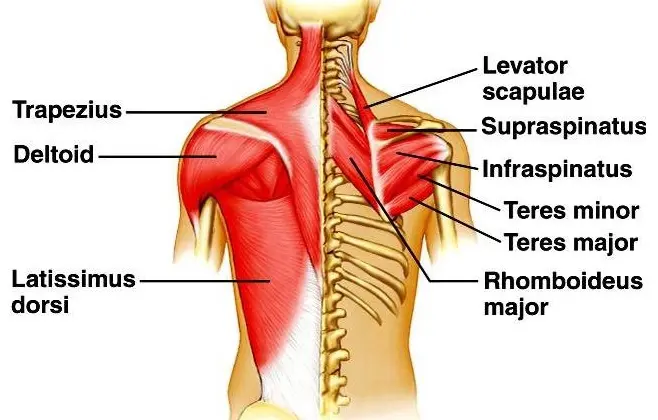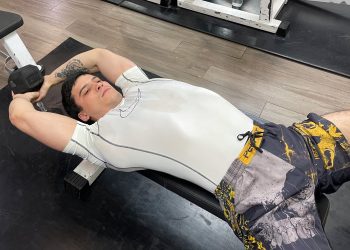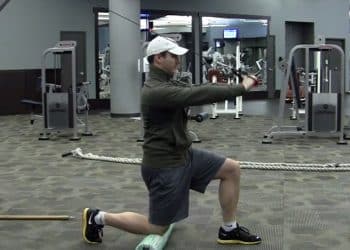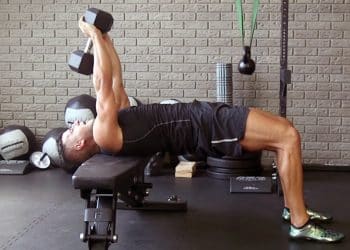When it comes to building a broader, more muscular back, most lifters automatically gravitate toward compound exercises like pull-ups, chin-ups, pulldowns, and bent-over rows. Each of these exercises are proven mass builders and are among the best moves for building back width and thickness.
But just as you probably use isolation exercises to work your chest and shoulders more thoroughgoingly, why not do some isolation exercises for your back, too?
In this article, we turn the spotlight on a very underappreciated lat exercise – the standing cable pullover. Learn why and how to do it, plus the seven best variations and alternatives.
Standing Cable Pullovers – Muscles Worked
The standing cable pullover, also known as straight arm pulldowns, is an isolation exercise. That means they involve movement at just one joint – the shoulder. In contrast, compound exercises involve two or more joints working together, such as lat pulldowns.
Despite being an isolation exercise, standing cable pulldowns involve several important muscles:

Level Up Your Fitness: Join our 💪 strong community in Fitness Volt Newsletter. Get daily inspiration, expert-backed workouts, nutrition tips, the latest in strength sports, and the support you need to reach your goals. Subscribe for free!
Latissimus dorsi – known as the lats for short, these muscles are located on the side of your upper back. The lats basically attach your arms to your torso and are responsible for shoulder joint adduction, extension, and medial rotation. Standing cable pullovers are a shoulder extension exercise. When well-developed, the lats can look a little like muscular wings.
Trapezius – this large, diamond-shaped muscle makes up much of your upper back. Located across and between the shoulder blades, the traps are divided into three sections: upper, middle, and lower. During standing cable pulldowns, the mid traps pull your shoulders back while the lower traps hold your shoulders down. The upper traps are not really involved in this exercise.
Posterior deltoid – the posterior or rear deltoid is the rearmost shoulder muscle. It works with the lats to extend the shoulder joint. The other two deltoid heads are the anterior (front) and medial (side).
Triceps brachii – usually just called the triceps, this muscle is located on the back of your upper arm. While the triceps are mostly an elbow extender, the long head also crosses the shoulder joint and, as such, it plays a part in shoulder extension. That’s why you may feel standing cable pullovers in your triceps as well as your lats.
Rectus abdominis – while standing cable pullovers are most definitely a lat exercise, you’ll also feel this exercise in your abs. That’s because you’ll need to use this abdominal muscle to keep your lumbar spine locked in place.
How to Do Standing Cable Pullovers
Get more from standing cable pullovers while keeping your risk of injury to a minimum by following these guidelines:
- Attach a straight bar to a high pulley machine, such as a lat pulldown. Hold the handle with a shoulder-width, overhand grip.
- With straight arms, step back to tension the cable and then lean forward slightly from the hips. Your arms should be extended overhead, with your biceps next to your ears. Brace your abs and pull your shoulders down and back.
- Without bending your arms, press the bar downward in an arc until it touches your thighs. Keep your chest up, and core braced.
- Slowly raise the bar back up until your arms are in line with your body, but do not let the weights touch down.
- Continue for the desired number of repetitions.
Watch Fitness Volt’s training editor, Enrique demonstrates perform the Standing Cable Pullovers:
You can also do this exercise using a rope handle. This allows you to use a neutral grip and also means that you can pull your hands down past your hips, increasing the range of motion. Try using a straight bar and a rope handle and see which option you prefer.
Standing Cable Pullover Benefits and Drawbacks
Not sure if standing cable pullovers are the right lat exercise for you? Consider these benefits and then decide!
Very lower back-friendly – providing you brace your core and do not hyperextend your spine, the standing cable pullover is very easy on the lower back. It’s certainly more comfortable than most bent-over row variations. This is a good lat exercise for anyone with low back pain.
Isolate your lats – unlike most back exercises, standing cable pullovers do NOT involve your biceps. While there is nothing wrong with doing mostly compound back exercises, it’s good to have a way to target your lats more precisely and without also training your bis. Isolating your lats can help strengthen your mind-muscle connection.
Easy to learn – the standing cable pullover is a very straightforward exercise. It’s easy to learn and master, so it’s ideal for beginners. Also, you can easily change the weights so you can make this exercise as easy or as hard as needed.
Better shoulder mobility and flexibility – standing cable pullovers involve a large range of motion. Moving your limbs through large ranges of motion can help improve mobility and flexibility. If you have tight shoulders, this exercise could help loosen them up.
A functional exercise for swimmers and throwers – isolation exercises are sometimes branded as non-functional, meaning they have little or no carryover to activities outside of the gym. However, standing cable pullovers replicate the actions of swimming and throwing, e.g., tossing a football. As such, they’re a good exercise for athletes.
Perfect for drop sets – drop sets provide let you extend your set beyond failure. You do as many reps as you can with your chosen weight, and then, as your muscles fatigue, you decrease the weight by 10 to 15% and pump out a few more reps. You can reduce (or drop) the weight several times to really exhaust the target muscles. With standing cable pullovers, the weight stack is in easy reach, making this exercise perfect for lat-pumping drop sets.
While standing cable pullovers are a mostly beneficial exercise, there are also a few drawbacks to consider:
Core strength may be a limiting factor – it doesn’t matter how strong your lats are; if your core is weak, you may be unable to do this exercise correctly. Lack of core strength also will limit the number of reps you can perform and determine how much weight you can lift.
Level Up Your Fitness: Join our 💪 strong community in Fitness Volt Newsletter. Get daily inspiration, expert-backed workouts, nutrition tips, the latest in strength sports, and the support you need to reach your goals. Subscribe for free!
Using too much weight will mess with your technique – this is an isolation exercise which means it focuses a lot of muscle tension on a small area of your body. It lets you really “zero in” on your lats. But, if you try to use too much weight, you’ll end up using ancillary muscle groups and take the stress off your lats. It’s better to go light and do more reps than go heavy and make this exercise less effective.
You need a high pulley machine – while most gyms have lat pulldown and cable crossover machines to do this exercise, if you train at home, you may not have the necessary equipment to do this exercise. That said, there are several non-cable alternatives you can do that are every bit as effective.
7 Standing Cable Pullover Variations and Alternatives
Standing cable pullovers are a highly effective lat isolation exercise, but that doesn’t mean you need to do them all the time. There are several variations and alternatives you can use to keep your workouts productive and interesting:
1. Supine cable pullover
The standing cable pullover is an excellent lat isolation exercise. However, you need a strong core to do it, and some people cannot help but hyperextend their spines during the movement. Supine or lying cable pullovers are much more lower-back friendly and provide a more comfortable way to do this exercise.
How to do it:
- Attach a rope handle or straight bar to a low cable machine. Place a bench in front of the pulley. Lie on the bench with your head nearest the handle. Hold the handle and pull your arms up until they are vertical. Brace your abs and plant your feet firmly on the floor.
- With a slight bend in your elbows, lower your arms backward until your biceps are almost touching your ears.
- Pull your arms back to upright and repeat.
- You can also do this exercise while lying on the floor instead of on a bench.
2. Incline cable pullover
When it comes to building muscle, angles matter. If you do the same exercise over and over, it will start to lose its potency. This cable pullover variation allows you to hit your lats in a slightly different way, which could be the key to avoiding training plateaus. It’s not better than standing or supine cable pullovers, but it’s different enough to be useful.
How to do it:
- Attach a rope handle or straight bar to a high pulley machine. Put an adjustable bench in front of the pulley. Set the bench to around 45 degrees. Sit on the bench with your head raised and nearest the cable machine.
- Reach up and grab the handle, so your arms are extended, elbows almost straight.
- Without bending your elbows, pull the handle over and down to your thighs.
- Raise your arms and repeat.
3. Standing resistance band pullover
No pulley machine? No problem! You can replicate standing cable pullovers using a basic resistance band. This is the ideal training solution for home and garage exercisers.
On the downside, there is very little resistance at the start of each rep – it all comes on at the mid-point. This small issue aside, this is a great way to isolate your lats without using weights.
How to do it:
- Attach your resistance band to a high anchor point. Hold the band in both hands and step back. Extend your arms, brace your core, and lean forward slightly at the hips.
- Without bending your elbows, pull your hands down and back to your thighs.
- Raise your arms and repeat.
4. Dumbbell pullovers
You don’t need a cable machine to isolate your lats; you can do , instead. This old-school bodybuilding exercise works your chest and lats at the same time, making it a very time-efficient exercise. In fact, golden-era lifters revered this exercise so much that they called it the “upper body squat.”
How to do it:
- Lie on a flat or slightly declined bench. Hold a single dumbbell in your hands. Hold the weight over your chest with your arms slightly bent but rigid.
- Lower the weight back and over your head until your biceps are next to your ears.
- Pull the dumbbell back up and over your chest.
- You can also do this exercise with a dumbbell in each hand or using a barbell.
5. Rollout
No, you haven’t inadvertently wandered onto an article about abs training! The rollout uses a very similar action to standing cable pullovers which means, as well as working your core, they also train your lats. This is a great low-tech cable pullover alternative for home exercisers. And yes, rollouts are also an excellent abs exercise.
How to do it:
- Kneel down and hold your abs roller in both hands. Place it on the floor in front of your knees. Brace your core, straighten your arms, and make sure your spine is neutral, i.e., not rounded or extended.
- Push the roller away from you and lower your upper body toward the floor. Try to extend your arms as far as possible without hyperextending your spine.
- Using your lats and abs, pull the roller back toward your legs, lifting your chest away from the floor as you do so.
- Make this exercise harder by doing it from standing or wearing a weighted vest.
6. Pullover machine
Does your gym have a pullover machine? If so, consider yourself VERY lucky! The pullover machine is one of the best ways to isolate your lats, and most machines are designed so you can also hit them with heavy weights.
How to do it:
- Sit on the machine and adjust the seat, so your shoulders are in line with the lever arm pivot point. Press down on the foot peddle to bring the bar forward. Place your elbows on the arm pads and grip the handlebar firmly.
- Release the foot peddle, take the weight, and raise your arms, so your biceps are next to your ears.
- Pull your arms down and back until the handle touches your abdomen.
- Raise your arms, get a stretch in your lats, and repeat.
7. Suspension trainer pullover
Another way to isolate your lats without a cable machine is the suspension trainer pullover. This bodyweight exercise also works your abs. Suspension trainers, such as a TRX, are highly functional, and you can use them to replicate almost any freeweight or machine exercise. They also add an extra dimension to bodyweight training.
How to do it:
- Set your suspension trainer to around waist height. Hold the handles and extend your arms in front of you. Lean forward slightly. Brace your abs.
- Raise your arms above your head as you simultaneously lean forward. Keep your core tight, and do not hyperextend your spine.
- Push down on the handles to lift your body back up and into the starting position.
- You can also do this exercise kneeling instead of standing.
Standing Cable Pullover – Wrapping Up
While there is nothing wrong with doing plenty of pull-ups, pulldowns, and rows to train your lats, even those mighty back exercises will start to lose their potency if that’s all you ever do. Doing the same exercises over and over is like eating the same meal – even if it’s your favorite, it’ll eventually get boring.
So, keep your training fresh and interesting by adding cable pullovers to your back workouts. And don’t just do the basic standing option – try the seven variations and alternatives described in this article.
A wide, muscular back doesn’t happen by accident. Use these exercises to build lats you can be proud of!
Interested in measuring your progress? Check out our strength standards for Dumbbell Pullover, Pull Ups, Chin Ups, and more.








